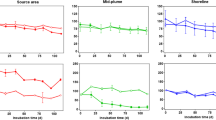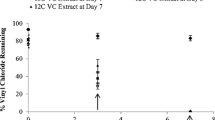Abstract
Vinyl chloride (VC) is a known human carcinogen and common groundwater contaminant. Reductive dechlorination of VC to non-toxic ethene under anaerobic conditions has been demonstrated at numerous hazardous waste sites. However, VC disappearance without stoichiometric production of ethene has also been observed at some sites and in microcosms. In this study we identify an organism responsible for this observation in presumably anaerobic microcosms and conclude that oxygen was not detectable based on a lack of color change from added resazurin. This organism, a Mycobacterium sp. closely related to known VC oxidizing strains, was present in high numbers in 16S rRNA gene clone libraries from a groundwater microcosm. Although the oxidation/reduction indicator resazurin remained in the clear reduced state in these studies, these results suggest inadvertent oxygen contamination occurred. This study helps to elucidate the dynamic behavior of chlorinated ethenes in contaminated groundwater, through the isolation of a strictly aerobic organism that may be responsible for at least some disappearance of VC without the concomitant production of ethene in groundwater considered anaerobic.




Similar content being viewed by others
References
Aggarwal K, Choe LH, Lee KH (2005) Quantitative analysis of protein expression using amine-specific isobaric tags in Escherichia coli cells expressing rhsA elements. Proteomics 5(9):2297–2308. doi:10.1002/pmic.200401231
Apolinario E, Sowers K (1996) Plate colonization of Methanococcus maripaludis and Methanosarcina thermophila in a modified canning jar. FEMS Microbiol Lett 145(1):131–137
Bradley P (2000) Microbial degradation of chloroethenes in groundwater systems. Hydrogeol J 8(1):104–111
Bradley P (2011) Reinterpreting the importance of oxygen-based biodegradation in chloroethene-contaminated groundwater. Ground Water Monit Remediat 31(4):50–55
Bradley P, Chapelle F (1996) Anaerobic mineralization of vinyl chloride in Fe(III)-reducing, aquifer sediments. Environ Sci Technol 30(6):2084–2086
Bradley P, Chapelle F (1997) Kinetics of DCE and VC mineralization under methanogenic and Fe(III)-reducing conditions. Environ Sci Technol 31(9):2692–2696
Bradley P, Chapelle F (1998) Microbial mineralization of VC and DCE under different terminal electron accepting conditions* 1. Anaerobe 4(2):81–87
Bradley P, Chapelle F (1999) Methane as a product of chloroethene biodegradation under methanogenic conditions. Environ Sci Technol 33(4):653–656
Bradley P, Chapelle F (2000) Acetogenic microbial degradation of vinyl chloride. Environ Sci Technol 34(13):2761–2763
Bradley P, Chapelle F, Lovley DR (1998) Humic acids as electron acceptors for anaerobic microbial oxidation of vinyl chloride and dichloroethene. Appl Environ Microbiol 64(8):3102
Burns M, Sublette KL, Sobieraj J, Ogles D, Koenigsberg S (2013) Concurrent and complete anaerobic reduction and microaerophilic degradation of mono-, di-, and trichlorobenzenes. Remediat J 23(3):37–53
Cadillo-Quiroz H, Brauer SL, Yashiro E, Sun C, Yavitt JB, Zinder SH (2006) Vertical profiles of methanogenesis and methanogens in two contrasting acidic peatlands in central New York State USA. Environ Microbiol 8(8):1428–1440
Coleman NV, Spain JC (2003) Epoxyalkane: coenzyme M transferase in the ethene and vinyl chloride biodegradation pathways of mycobacterium strain JS60. J Bacteriol 185(18):5536–5545. doi:10.1128/JB.185.18.5536-5545.2003
Coleman N, Mattes T, Gossett J, Spain JC (2002) Phylogenetic and kinetic diversity of aerobic vinyl chloride-assimilating bacteria from contaminated sites. Appl Environ Microbiol 68(12):6162
Cupples A, Spormann AM, McCarty P (2004) Vinyl chloride and cis-dichloroethene dechlorination kinetics and microorganism growth under substrate limiting conditions. Environ Sci Technol 38(4):1102–1107
Dean-Ross D, Cerniglia C (1996) Degradation of pyrene by Mycobacterium flavescens. Appl Microbiol Biotechnol 46(3):307–312
Felsenstein J (2005) PHYLIP (Phylogeny Inference Package) version 3.6. Distributed by the author Department of Genome Sciences, University of Washington, Seattle
Fullerton H, Crawford M, Bakenne A, Freedman DL, Zinder SH (2013) Anaerobic oxidation of ethene coupled to sulfate reduction in microcosms and enrichment cultures. Environ Sci Technol 47(21):12374–12381
Gossett J (2010) Sustained aerobic oxidation of vinyl chloride at low oxygen concentrations. Environ Sci Technol 44(4):1405–1411
He J, Ritalahti K, Yang K, Koenigsberg S, Loffler FE (2003) Detoxification of vinyl chloride to ethene coupled to growth of an anaerobic bacterium. Nature 424(6944):62–65
He J, Sung Y, Krajmalnik-Brown R, Ritalahti KM, Loffler FE (2005) Isolation and characterization of Dehalococcoides sp. strain FL2, a trichloroethene (TCE)- and 1,2-dichloroethene-respiring anaerobe. Environ Microbiol 7(9):1442–1450. doi:10.1111/j.1462-2920.2005.00830.x
Hendrickson ER, Payne JA, Young RM, Starr MG, Perry MP, Fahnestock S, Ellis DE, Ebersole RC (2002) Molecular analysis of Dehalococcoides 16S ribosomal DNA from chloroethene-contaminated sites throughout North America and Europe. Appl Environ Microbiol 68(2):485–495
Jin Y, Mattes T (2010) A quantitative PCR assay for aerobic, vinyl chloride-and ethene-assimilating microorganisms in groundwater. Environ Sci Technol 44(23):9036–9041
Kamala T, Paramasivan CN, Herbert D, Venkatesan P, Prabhakar R (1994) Evaluation of procedures for isolation of nontuberculous mycobacteria from soil and water. Appl Environ Microbiol 60(3):1021–1024
Kleopfer R, Easley D, Haas B Jr, Deihl T, Jackson D, Wurrey C (1985) Anaerobic degradation of trichloroethylene in soil. Environ Sci Technol 19(3):277–280
Lee L, Ding C, Yang K, He J (2011) Complete Debromination of Tetra-and Penta-Brominated Diphenyl Ethers by a Coculture Consisting of Dehalococcoides and Desulfovibrio Species. Environ Sci Technol 45(19):8475–8482
Mattes TE, Coleman NV, Chuang AS, Rogers AJ, Spain JC, Gossett J (2007) Mechanism controlling the extended lag period associated with vinyl chloride starvation in Nocardioides sp. strain JS614. Arch Microbiol 187(3):217–226. doi:10.1007/s00203-006-0189-2
Mattes TE, Alexander AK, Coleman NV (2010) Aerobic biodegradation of the chloroethenes: pathways, enzymes, ecology, and evolution. FEMS Microbiol Rev. doi:10.1111/j.1574-6976.2010.00210.x
Maymo-Gatell X, Tandoi V, Zinder SH (1995) Characterization of an H2-utilizing enrichment culture that reductively dechlorinates tetrachloroethene to vinyl chloride and ethene in the absence of methanogenesis and acetogenesis. Appl Environ Microbiol 61(11):3928
Maymo-Gatell X, Chien Y, Gossett J, Zinder SH (1997) Isolation of a bacterium that reductively dechlorinates tetrachloroethene to ethene. Science 276(5318):1568
Maymo-Gatell X, Anguish T, Zinder SH (1999) Reductive dechlorination of chlorinated ethenes and 1, 2-dichloroethane by" Dehalococcoides ethenogenes" 195. Appl Environ Microbiol 65(7):3108
Maymo-Gatell X, Nijenhuis I, Zinder SH (2001) Reductive dechlorination of cis-1, 2-dichloroethene and vinyl chloride by Dehalococcoides ethenogenes. Environ Sci Technol 35(3):516–521
Miller CD, Child R, Hughes JE, Benscai M, Der JP, Sims RC, Anderson AJ (2007) Diversity of soil mycobacterium isolates from three sites that degrade polycyclic aromatic hydrocarbons. J Appl Microbiol 102(6):1612–1624. doi:10.1111/j.1365-2672.2006.03202.x
Mundle SOC, Johnson T, Lacrampe-Couloume G, Pérez-de-Mora A, Duhamel M, Edwards EA, McMaster ML, Cox E, Révész K, Sherwood Lollar B (2012) Monitoring Biodegradation of Ethene and Bioremediation of Chlorinated Ethenes at a Contaminated Site Using Compound-Specific Isotope Analysis (CSIA). Environ Sci Technol 46(3):1731–1738. doi:10.1021/es202792x
Pruesse E, Peplies J, Glockner FO (2012) SINA: accurate high-throughput multiple sequence alignment of ribosomal RNA genes. Bioinformatics 28(14):1823–1829. doi:10.1093/bioinformatics/bts252
Tamura K, Peterson D, Peterson N, Stecher G, Nei M, Kumar S (2011) MEGA5: molecular evolutionary genetics analysis using maximum likelihood, evolutionary distance, and maximum parsimony methods. Mol Biol Evol 28(10):2731–2739. doi:10.1093/molbev/msr121
Thauer R, Jungermann K, Decker K (1977) Energy conservation in chemotrophic anaerobic bacteria. Microbiol Mol Biol Rev 41(1):100
Verce MF, Ulrich RL, Freedman DL (2000) Characterization of an isolate that uses vinyl chloride as a growth substrate under aerobic conditions. Appl Environ Microbiol 66(8):3535–3542
Acknowledgments
We gratefully acknowledge funding provided by the Strategic Environmental Research and Development Program (SERDP) project ER-1556.
Author information
Authors and Affiliations
Corresponding author
Electronic supplementary material
Below is the link to the electronic supplementary material.
Rights and permissions
About this article
Cite this article
Fullerton, H., Rogers, R., Freedman, D.L. et al. Isolation of an aerobic vinyl chloride oxidizer from anaerobic groundwater. Biodegradation 25, 893–901 (2014). https://doi.org/10.1007/s10532-014-9708-z
Received:
Accepted:
Published:
Issue Date:
DOI: https://doi.org/10.1007/s10532-014-9708-z




